It is not easy to talk about Correggio in this age where we are accustomed to strong emotions, excitable actions, sharp contrasts, we appreciate only what excites us violently. This temperament of ours, combined with the fact thatAllegri did not work in a major center of Italian art, is perhaps the reason why Correggio’s work does not find such great fame among the general public. His delicate feelings, his unconditional joy, the atmosphere of serene calmness that invariably permeates his creations struggle to reach our souls, accustomed to quite other energies, accelerations, impressions, and by these perhaps ultimately somewhat hardened. But Correggio was one of the greatest artistic geniuses of all time, as FedericoZeri1 had defined him. His career began quietly, in the provinces, at the workshop of a modest painter, Francesco Bianchi Ferrari, whose influence is felt only in the expressiveness of his first known drawing (figs. 1,2 ). In any case, his beginnings were outside the membership of the great artistic schools of his time, but in him grew gradually with urgency the desire to learn, even independently, the pictorial achievements and advances that flourished all around him at the height of the Renaissance.
In his youthful paintings the influences, and consequently the study, of the works of the greatest contemporary artists, first those placed nearby, Mantegna, the Ferrara people, Leonardo, and then most recently Michelangelo and Raphael, whose knowledge must have come through the ’inescapable trip to Rome, become very evident. A “studious course” of updating himself on the pictorial innovations of his period, which he shared with so many other artists of his time. But then later something inexplicable will happen: from the time of his stay in Parma, Correggio develops a totally new model of art, which can no longer be defined as the child of any of the previous masters, it is no longer possible to trace within it the influence of one or the other, this new paradigm was totally his own and personal, created only by his pictorial genius : “Un miracol d’arte senza esempio.” The inventions of the great masters that fueled his exercises in the timid beginnings of his youth are absorbed, assimilated and then annihilated, by the explosion of the bursting personality of his painterly innovation , in the dome of the Duomo a zero point is almost realized that makes a tabula rasa to start anew through something radically different from what he had previously developed in the field of art. After this fundamental turning point none of the canonical elements of pictorial composition will remain the same as before : light, color, movement and action, forms and linear course of drawing, way of expressing feelings, conception of space, will be completely transformed. But if we were limited to this we could define Correggio as one of those individual and extraordinary geniuses who led an isolated career and in many cases dotted our painting. Instead, all of Correggio’s innovations were destined to change the course of art for at least the next three centuries, that is, at least until Tiepolo, although the influences of his models can even be felt in Courbet. His inventions nourished all Baroque art: Annibale Carracci, Bernini, Lanfranco, Rubens, drew from him, and from these fundamental ganglia Correggio’s sap passed into the art of all others, the whole of the eighteenth century even internationally will be indebted to his pictorial achievements2. There was no painter who later, would not take example from his painting “without example,” who in his development had no other models of reference than his individual genius, given that moreover he worked in the context of a small provincial town, untied from the trends and research of the great metropolises. And this in a way was also a good thing, his condition sheltered him from the danger of homologation, in an extreme edge, on the fringes of the Italy “that counts,” without any light to illuminate his way, he in solitude pushed the accelerator in a direction only known to him : “one man in charge,” he would thus illuminate the path of those who would come after him.
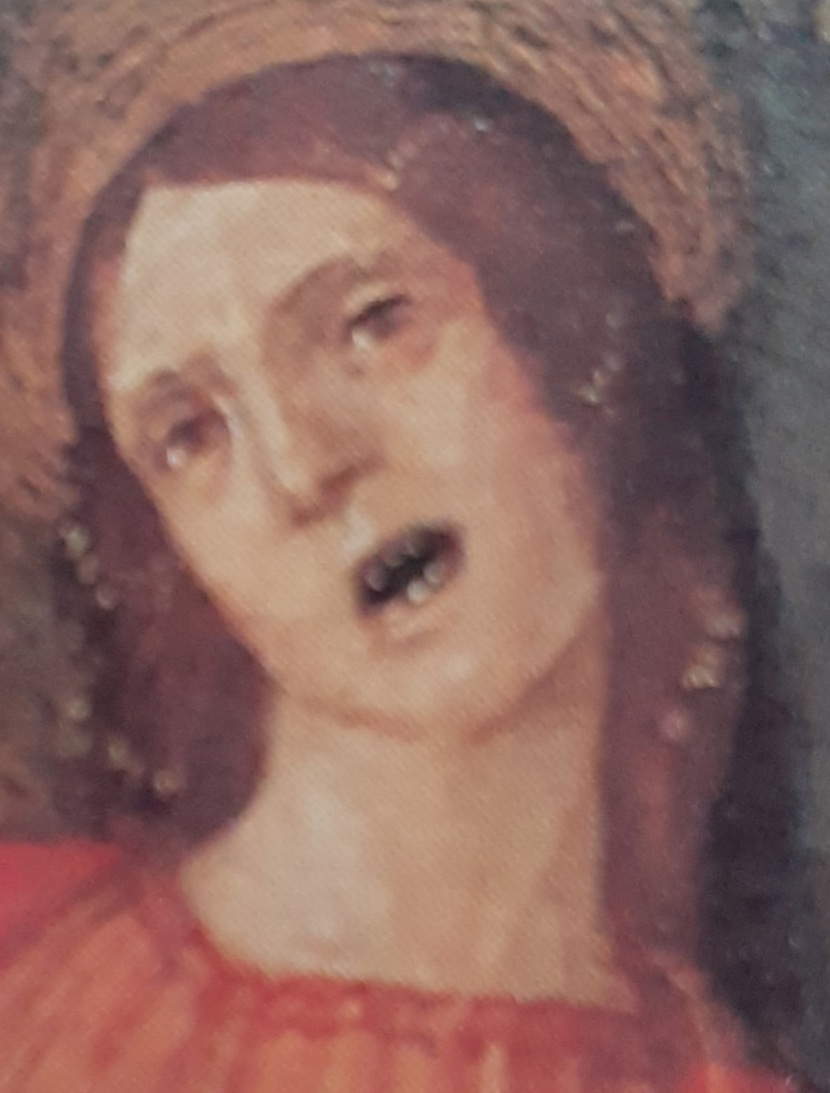 |
| 1. Francesco Bianchi Ferrari, Crucifixion, detail (oil on panel, 42 x 27 cm; Cremona, Pinacoteca Civica) |
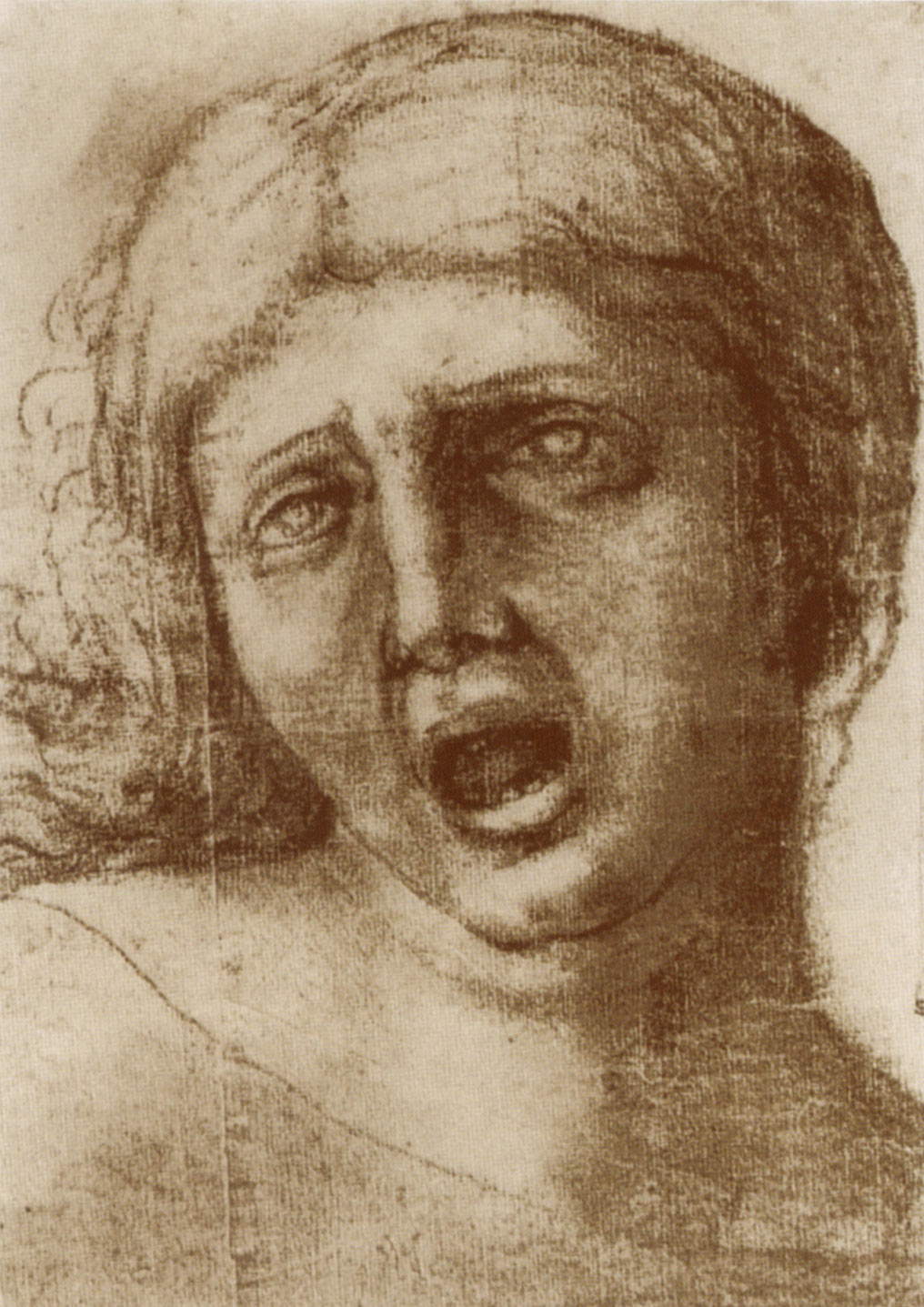 |
| 2. Correggio, Magdalene, from the cartoon for the Deposition in the Mantegna Chapel in Sant’Andrea in Mantua (c. 1509-1511; charcoal, black chalk and white chalk on two sheets of glued paper, 321 x 225 mm; New York, The Pierpont Morgan Library) |
A new idea of space
Why was Correggio so beloved by painters? First we can think because of the radical novelty of his idea of space: Correggio is the first painter to completely transform the “two-dimensional” and terrestrial perspective of the Florentines into a “three-dimensional” and celestial perspective. If we then consider how difficult it already is to rationally arrange the figures on the flat space of a wall while avoiding distortion for those looking from below, imagine how much more complex it was to calculate the dimensions of the various parts in order to achieve the desired effect in the curved space of a vault. Considering also that the domes Correggio had at his disposal were not hemispheres as one might think, but in fact one (San Giovanni) had unequal sides and that is, the shape of a basin, and the other (Il Duomo) was octagonal and that is, made in segments. In these works, as well as in his paintings, Correggio, in order to give the appearance of space, refuses to resort to linear-prospective expedients, which characterized the trials of his predecessors. Think of Michelangelo: in the Judgment there is an orderly and balanced arrangement of the masses to which is superimposed a logical subdivision of humanity from bottom to top. When he paints the vault of the Sistine Chapel then, he organizes the space at his disposal still in an orderly and geometric manner following a thread that punctuates the events according to a chronological succession, the scenes are painted as if they were squares shown on the ceiling, and this brings out even more how the locus of his representation is always that of terrestrial perspective, that is, the figures are placed on a plane parallel to the intuitive line of the horizon toward which their lines inexorably converge.
The same principle of perspective is applied by Raphael on the walls of the Vatican, where the figures are arranged in a very pure, perfectly calculable space that more often than not pivots on the classic central vanishing point, and this should come as no surprise at all given that Raphael comes from the capital of mathematical renaissance, namely Urbino. The most complex scene is that of the Dispute, which is again organized according to the principle of terrestrial perspective, but in this case it is divided into several levels, placed frontally to the observer: an idea that will have a certain following and that we find in the dome of Florence Cathedral, in Tintoretto’s Paradise and in the Glory of the Escorial, where Luca Cambiaso reaches his highest level of abstraction, just pure color, surfaces and volumes. In the vaults he repeats the kind of approach we have already been able to appreciate in Michelangelo, while in the Farnesina he experiments with true tromp l’oeil, as if they were reported canvases. In any case, for both of these masters the figures rest firmly on top of the ground they tread and are static, precisely in deference to that principle of gravity from which the minds of their creators cannot get away-even if they are painted on the ceiling the viewer must imagine them as looking at a wall, otherwise inexorably the figures would fall over the viewer.
Finally we come to Leonardo, who as we know did not paint much; the Last Supper, his masterpiece, offers a space rigidly determined on the basis of the ideal vanishing point that the walls hint at. To him, however, we owe the definition of aerial perspective, which, because of the interposition of layers of air, provides for a progressive modification of the tones, and colors of objects as they move away from the foreground.
This probably had a certain influence on Allegri, who this for purpose uses a complex and studied combination of light, color, proportional ratios and above all movement: the kineticism of the limbs of his figures fragments the geometric rigidity of the lines of ideal space, into an unlimited number of vanishing points, which the mind can no longer reconstruct and reduce to a synthetic type of logic, as is also the case in nature. Correggio’s characters are finally freed from the constraint of gravity, the absolutely necessary link to the concept of terrestrial perspective; they are perfectly in control of the three-dimensional space in which they live and completely free to twirl happily in it, almost acrobatically, as seen in the beautiful pose of the angel from behind in the vault of the Duomo. The figures in this fresco wrapped in an eccentric vortex, have been placed according to a principle of celestial perspective, that is, organized according to a vanishing point perpendicular to the horizon, consistent with their upward movement that now acts as a binder in place of the principle of gravity; moreover, they are projecting with respect to the point of view of an observer from below, in other words, they also move perpendicular to the plane on which they are painted: this increases the illusionistic effect of penetration into space, in this way the figures are clearly detached from the painted surface and appear in their own complete three-dimensionality, if they had not been placed foreshortened one would have run the perceptual risk of seeing them fall over the head of the viewer, it is an extraordinary expedient used by Correggio to neutralize the sense of looming characteristic of the curved surface he had at his disposal, his genius is capable of transforming even this limitation into a merit. In the dome of the cathedral (fig. 3) Correggio comes to conceive an idea of space of a complexity that had never before even been imagined let alone realized: we can now understand what Titian’s thoughts were when he said that not even the volume of the dome filled with gold would be a sufficient price to quantify its value. Lanfranco, who of all in this sense was his most direct heir, comes close to him in the dome of Sant’Andrea della Valle in Rome, which he succeeds, yes, in organizing as an ascending vortex, but his figures are in the end seated on the clouds that keep them bound, they are unable to detach themselves from the walls to which they remain glued, in the end we must conclude that no one can free himself from the bonds of gravity,not even in the mind, only Correggio knows how to “fly.”
The shape of the dome is perfectly perceivable with its concrete form, the imaginary space conceived by Lanfranco, and his ideas must eventually adapt to the structural limit and not vice versa as happens in Correggio: that absolute freedom of movement that loosens the figures from any ties and makes them so happy disappears, we will have to wait another fifty years and arrive at Father Pozzo to see again something comparable to the ineffable feast painted by Allegri. Correggio’s space does not look like a rational space but a natural one; it records and reflects what happens in reality, not what happens in the ideal perfection of the mind. When he tackles the description of a scene, he does not start from an imaginary construction that logically requires all the actors to be fully included in it: the Correggio, in order to give the greatest impression of verisimilitude to the action, does not perfectly include all the elements, which in part are cut out, voluntarily and arbitrarily limiting the field of the frame, just as the man’s field of vision is limited in reality; in other words, he composes the frame, as if he were filming a live scene, in a manner that is absolutely innovative. Thus, it is not the staging of a performance, on the contrary he wants to give the ’impression of portraying an action that is taking place right before his eyes, even though to our mind the overall picture may appear unbalanced in some ways. This intent appears with all evidence in the martyrdom of the four saints (fig. 4), where only two are placed in the center of the scene, the other two are barely glimpsed on the right, as a memory of an action that has just taken place.The conscious effort in the direction we have just described can be understood by comparing it with the first idea of the preparatory drawing (fig. 5), where all four saints are placed canonically and symmetrically in the center. The scale of the figures also changes; now they occupy the whole scene, the cut becomes closer, direct, urgent.
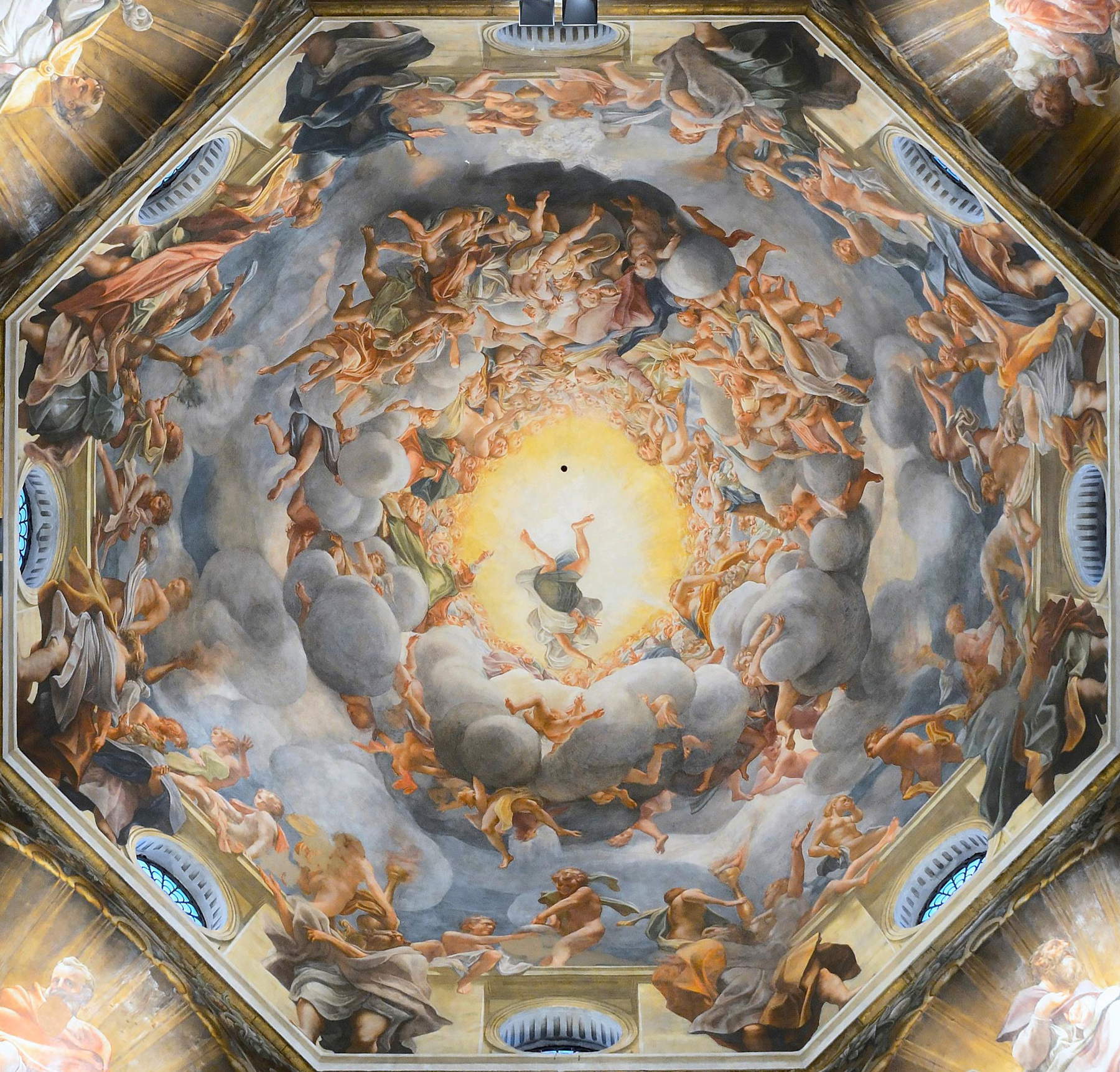 |
| 3. Correggio, Assumption of the Virgin (1522-1530; frescoes; Parma, Duomo) |
 |
| 4. Correggio, Martyrdom of Four Saints (c. 1523; oil on canvas, 157 x 182 cm; Parma, Galleria Nazionale) |
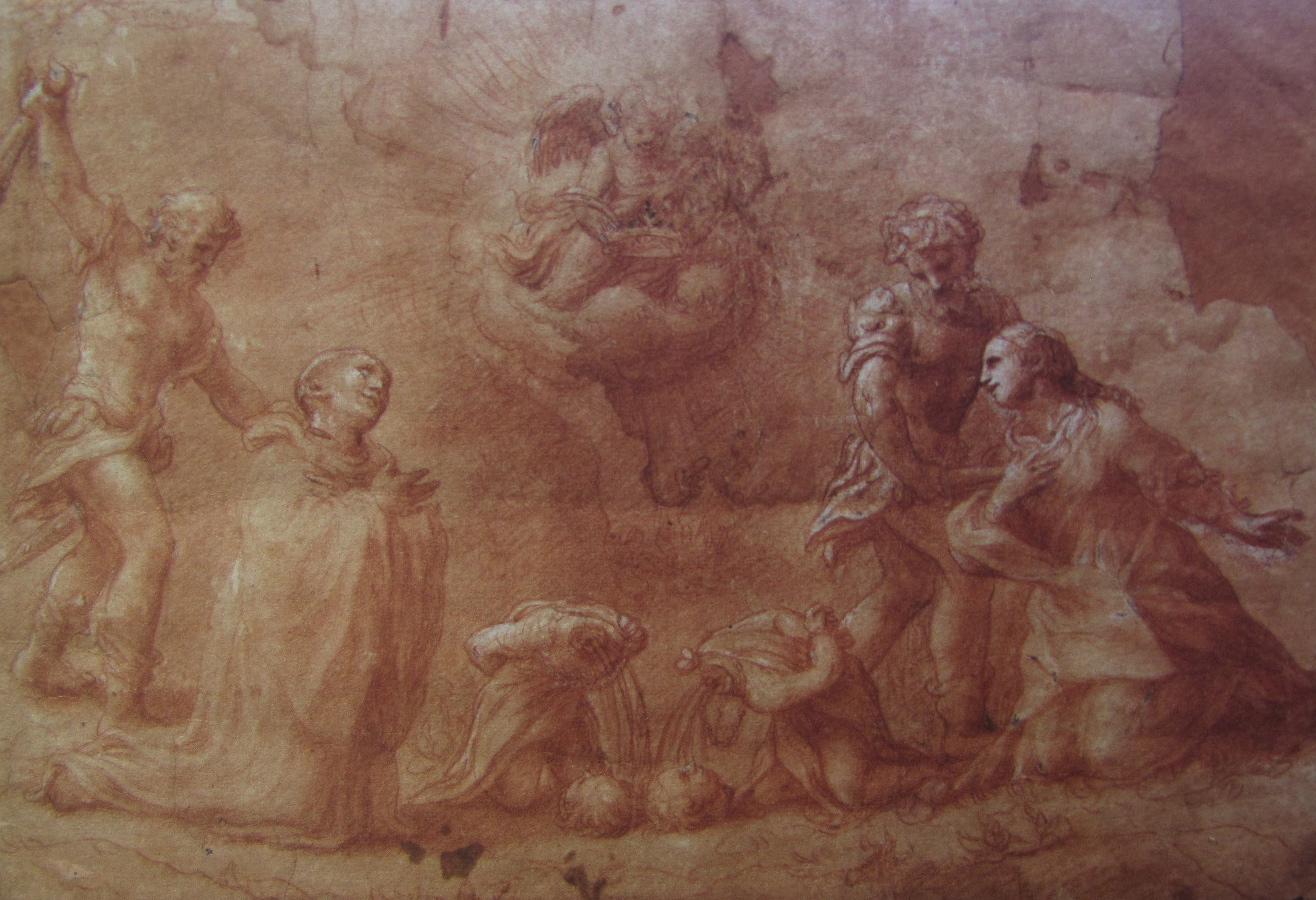 |
| 5. Correggio, Preparatory Study for Martyrdom of Four Saints (c. 1523; red pencil and raised to white, 215 x 305 mm; Paris, Louvre) |
Naturalness and feeling
Naturalness is the cardinal principle Correggio chooses to adopt, guiding him in all decisions: he reproduces exactly what he sees, even in the study of light, of which he was one of the greatest innovators,do you remember ever seeing a sky as completely white as the one in the Correggio Museum deposition? Yet if you notice, the sky in winter is almost always white, especially in the morning, as can also be seen in the splendid rippling of light in the Noli me tangere. Darkness, on the other hand, is the protagonist of the eclipse in the Mourning over Christ, just as the light that has now just disappeared with his death, shone among them at his birth, in the stupendous crepuscular nocturne of “Night,” one of Italian art’s earliest experiments in this direction. The golden light of a summer afternoon invades its counterpart, “the day” (fig. 6), that same warm, harmonious, happy light that pervades its domes. Correggio is fully master of all the nuances of the atmosphere, of which he manages to render even the elusive lightness of fog, not incidentally coupled with the soft flesh of the nymph in the Loves (fig. 7), but it is not only the atmosphere of nature that arouses his interest, but rather that which is given off by the delicacy of human feelings. This is the other area where Correggio makes a radical innovation; he refines a never again achieved ability to express emotions, which are always the focal point of his narrative. Serenity, sweetness are the melody to which all the protagonists of his works tune in, always openly manifesting their affective sphere, creating that feeling of mutual understanding and participation that flows into the overall harmony that distinguishes each of his paintings. Correggio once again does not choose to represent the heights of man’s rational mind, but the feeling of his heart, making a radical shift in this sense as well, and making the entire history of art do so, taking into account how much emotions and even sensuality were center stage in the Baroque era. Love, gentleness are always the protagonists of his narrative, even when the action becomes tragic the pathos is composed, on the faces of his martyrs there is no hint of sorrow but rather of bliss, explicable only by the certainty of Hope for those who are guided by the Spirit in their race toward an otherworldly goal. Correggio fully possessed a sense of the Divine, which he demonstrates with an unceasing, uninterrupted joy, and untethered from earthly happenings, “everything cooperates for the good of those who love God.”
Movement
The depiction of movement is the other major area where Correggio makes a radical innovation; there is no painting of his from his mature period where action is not at the center, and this along with feeling does not create a bond between his characters, just as there is no scene in nature where there is no movement, reality is once again his guide. This is also the expedient he uses to coordinate the figures within a painting and thus also give a harmonious structure to the space, something that becomes particularly evident in the dome of the Duomo, the most mind-blowing concertation of movements that has ever existed. Its draperies subdivided into a thousand soft facets, flaked into ever more complex folds, are the most direct consequence of the continuous movement that animates them, a perpetual agent activity that in his last works will turn more and more into wind, flutterings of cloths that foreshadow the Baroque taste that will be there to come. This new conception is completely irreconcilable with the search for classical balance, which always vague the measured harmony of Polyclitus, so typical of the Renaissance. There is only one cultural center that, in the Renaissance era, ventures in a different direction from the others: it is Ferrara, and this happens through the work of two fundamental artists who are Niccolò dell’Arcaand Ercole de’ Roberti, their genius fully revealed in the Lamentation over the Dead Christ, in Bologna, and in the predella of the Griffoni polyptych, emotion and movement are the two cornerstones of their art, which will also become the cornerstones of future art. It is this insight that probably prompted Roberto Longhi to write, “By the merit of Ercole, Ferrara sits, toward the last decade of the century, higher than anywhere else in Italy; and, by the force of Ferrara, Ercole conquers a position so personal that at that time he could find no other paragon of worth than in Leonardo. ”3
Correggio is a painter who represents more what he sees than what he imagines, more what he feels than what he thinks, or at least that is the illusion he wants to create. In fact, if looking at the qualities of his paintings, at this point we had gotten the idea of a painter all intuition and feeling, we would be very far from the truth. His rational faculties, his technical knowledge, his expertise in learning through incessant study were of the highest level and most refined. Beginning with his ability to analyze and study perspective problems, to make the necessary measurements by means of technical instruments, to arrange the figures of the domes, so as to avoid the optical distortions resulting from viewing a curved surface, and according to astronomical orientation, for which Geraldine Wind showed that he used the astrolabe4. Imagine the difficulty of transforming an idea that is forcibly conceived and drawn on a plane space and adapting it to a curved surface, as the quadrature subdivided by segments as a function of spherical space demonstrate in the drawing preserved in Frankfurt (fig. 8). Correggio’s aim in the top of the dome is to depict a harmonious ensemble of masses that must be visible from below without distortion, and once again he chooses not to resort to the use of rational, geometric and visibly artificial arrangements like his predecessors: for this purpose he uses the expedient of arranging an uninterrupted succession of movements that project upward in an upward and apparently random motion. Starting from this idea he solves the problem by designing from the initial stages the theory of the figures already in a perspective suitable for a point of view from below, and also in function of a curved space, as the circle on the upper part of the Frankfurt drawing, and the Windsor drawing stand to demonstrate, and moreover by not taking into any account the segmented division of the dome, as is the case instead in the lower part where the figures of the apostles rest: the two segmentations of the squareness of the Frankfurt sheet in fact do not coincide with the segments.
In this way he solves the problem of being able to give the space the form he imagined, hiding from view the shapes of the dome, which disappear completely, hidden by the vortex of his illusionistic ability: his drawing of the space is completely untied from the structure on which it is painted, and on it he imposes himself totally, freeing himself from its constraints. Before reaching this pinnacle, this turning point, Correggio also showed great skill in organizing the representation in a rational manner, as occurred in his first fresco in Parma, that of the Camera di San Paolo (fig. 9). This case is also faced with a dome made of triangular segments, but in his first exercise on the theme Correggio decided to integrate its structure into his design, while for the logical arrangement of the elements he chose to organize them according to the distribution provided by the Aristotelian square of syllogisms, normally used in the disciplines of logic and rhetoric. In this regard, it is worth noting how Lina Bolzoni5 notes the singular coincidence of the images contained in the abbess’s room, with those relating to Giulio Camillo’s theater. Giulio Camillo Delminio was a very famous scholar in his time, he was a teacher of rhetoric and also one of the most important scholars of combinatorial art of the Renaissance, as well documented by Frances Yates, and intuited by Gombrich6. News about his life is rather fragmentary, but we know that he was linked by sincere friendship with Veronica Gambara, the patroness of Allegri, from an exchange of sonnets that took place between the two7.
Also evident in the room is all the attention Correggio paid to the study of ancient iconographies, whose models he transcribed with precision in his lunettes, taking images from Roman coins and medals. But his knowledge of antiquity is obviously not limited only to these minute details, which also highlight the almost maniacal accuracy of his inquiring mind, but must also extend to the models of classical statuary as correctly analyzed in Marcin Fabianski’s study The Mythologies of ’Love. The same degree of care is found in the definition of the priest’s clothing, and in the objects featured in the Triumph of David, which reflect with extreme care the descriptions contained in the biblical passages. Also very complex and extremely thorough is the iconological design of the Abbey of St. John with that unique interweaving of Christian and pagan iconography that was then considered usual. We certainly cannot assume that Correggio designed all these elaborate programs, but he certainly had a way of absorbing the culture of the scholars who imagined them, then taking into account how faithful his paintings in practice were to the texts. From all of this we understand that Correggio was a very careful painter, very scrupulous, and it is striking that in the midst of the ideal world of the Renaissance he adheres instead to the principle of reality, of the representation of truth, he does not improvise, but rather studies before depicting, and in this he demonstrates something of the scientific spirit to come. That same spirit we see in the accurate description of botanical details in his works, a type of research that parallels that of Leonardo and Raphael. But his study is not limited to the field of “knowing”: it is also applied to the field of “making,” in the technique of materials. Correggio worked at a time of transition from painting on panel to painting on canvas, and at a time when there was a consequent transformation of the structure of the support for the color, “the bed,” which can be distinguished into two layers, the preparation, which is in contact with the canvas, above which is spread the imprimitura, which is contact with the pigment. Also in this field Correggio was part of the avant-garde, in fact he was one of the most important experimenters in the formulation of the first preparations based on earth and white lead and in the use of zoned colored imprimiture, in this field the only one with whom a comparison can be made was Raphael8.
If we then analyze the extraordinary evolution of his manner of painting, we cannot but be astonished; his beginnings are characterized by a delicate, subtle and careful drafting, almost of a miniaturist, which is well distinguished in the early work of the Mystic Marriage of St. Catherine in Washington (fig. 10), while his landings come to a fat, free and impetuous brushstroke that are the most striking features of the Vatican Museums’ Christ of the Apocalypse. A painting that, not surprisingly, for a long time was thought to be a copy of Carracci’s scope precisely because of this already fully seventeenth-century manner of spreading color: only recently have scientific analyses and historical studies been able to prove that it was the original.
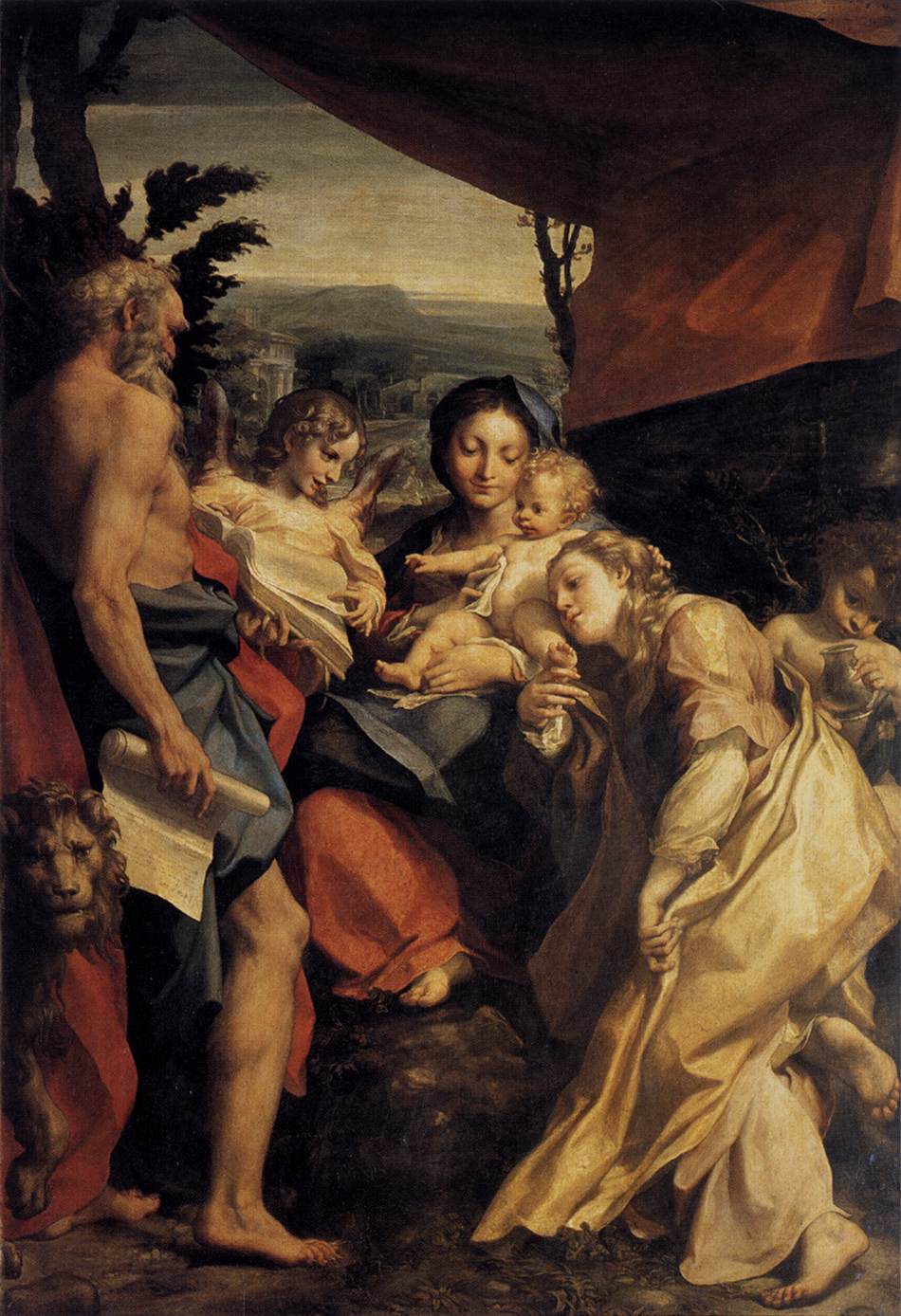 |
| 6. Correggio, Madonna di san Girolamo detta Il Giorno (1526-1528; oil on panel, 205 x 141 cm; Parma, Galleria Nazionale) |
 |
| 7. Correggio, Jupiter and Io (1531-1532; oil on canvas, 163 x 74 cm; Vienna, Kunsthistorisches Museum) |
 |
| 8. Correggio, Preparatory Study for theAssumption(red pencil, 260 x 357 mm; Frankfurt, Städelsches Kunsinstitute) |
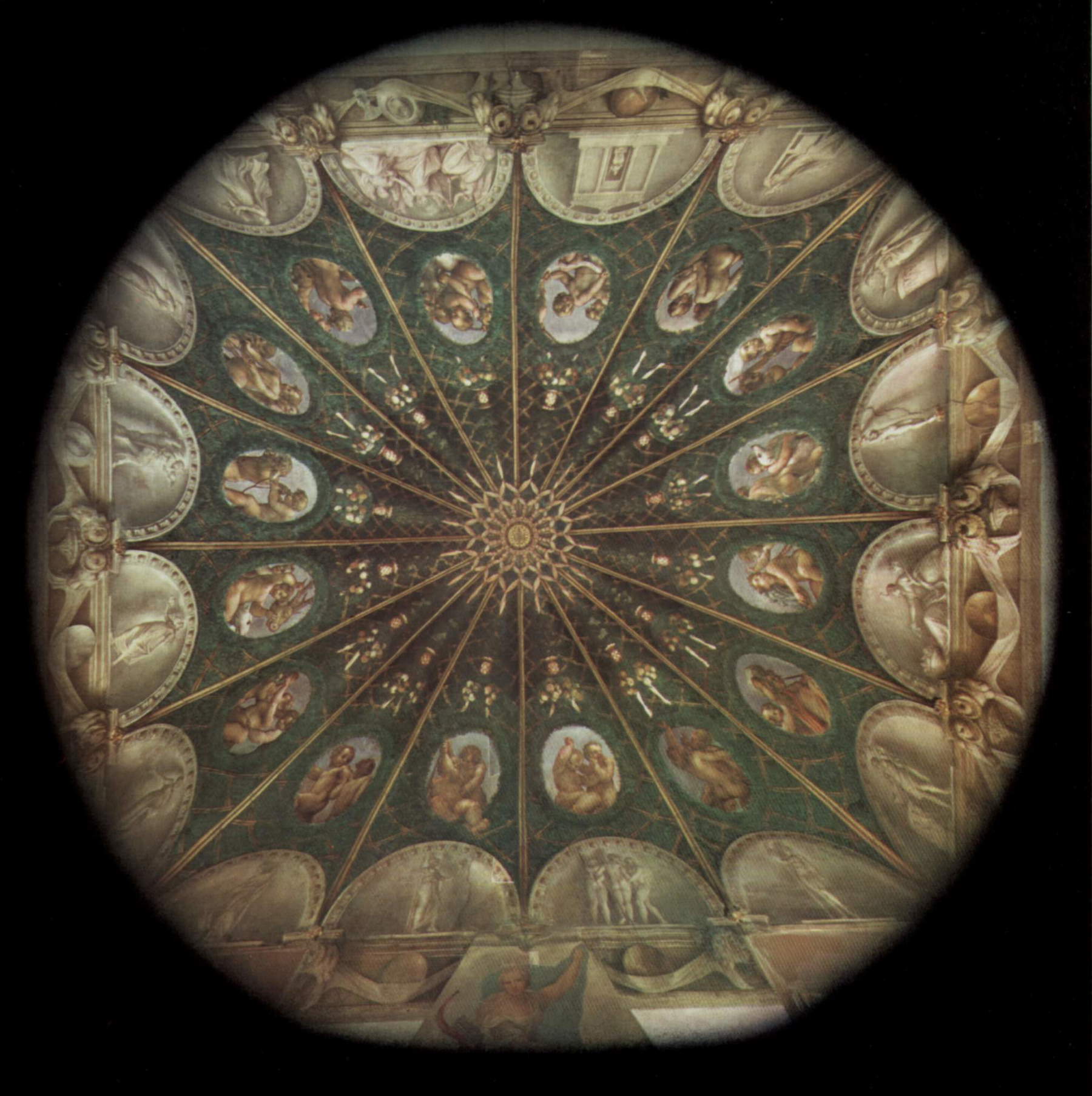 |
| 9. Correggio, Vault of the Camera di San Paolo (1518-1519; frescoes; Parma, Camera di San Paolo) |
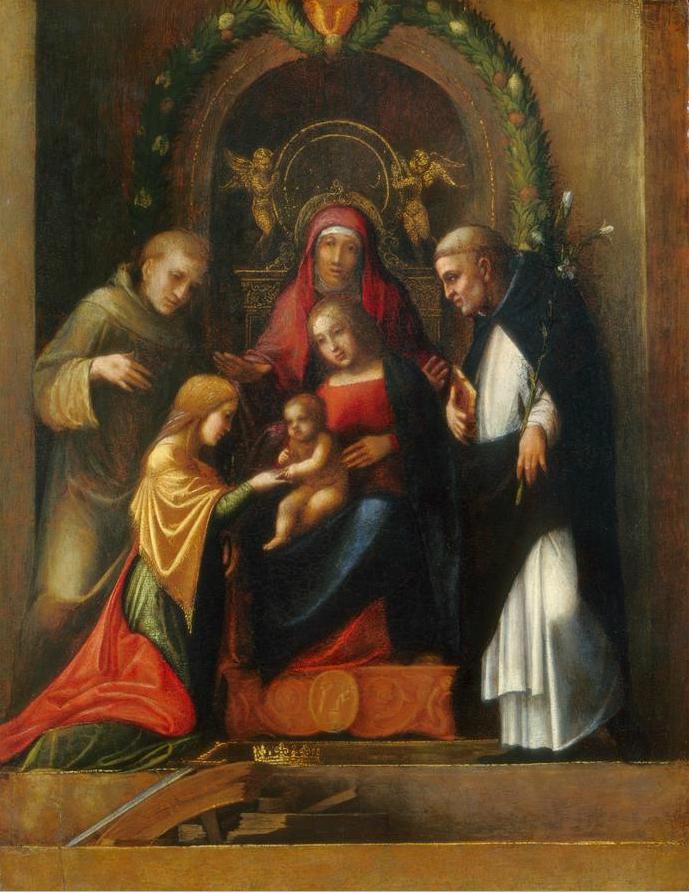 |
| 10. Correggio, Mystic Marriage of St. Catherine (1510-1511; panel, 27.8 x 21.3 cm; Washington, National Gallery of Art) |
In the light of this further evidence, one must come to the inescapable conclusion that Correggio, while holding firm to that balance which distinguished the Renaissance was already Baroque, or rather, his genius opened a path in painting that was interrupted by his death and was taken up by it only fifty years later. The assimilation of his inventions by the Baroque era happened in all senses: in the concept of space, in the attention to feelings, in sensuality, in the softness of forms, in the rendering of flesh, in the attention to movement, and even now we know, in pictorial drafting.
This was Correggio for painting, an unparalleled innovator.
Of course, it is not easy to talk about Correggio in this age thirsty for strong emotions, as Bernard Berenson said, “Men do not desire happiness, men desire to live, they aspire to a certain violence of sensations, to a mixture of pain and good, and for this they forgive without remorse the peace of mind. ”9 But when the emotions and adventure are over of these fires of the soul what remains? Only ashes that are lost in a puff, no maturation, no depth, no improvement. On the contrary, who among us in reality would not want to have at his or her side every day people endowed with that nature described by Allegri, endowed with understanding, kindness, humanity, simplicity, and being able, would not want to live immersed in an environment permeated by that atmosphere of serene affectivity that he miraculously succeeds in portraying?
Of course, it is not easy to understand Correggio for us who that world of his was never able to realize it, and are now so far removed from it that we no longer even have the ability to imagine it. But only that universe of human correspondences and understanding that Correggio describes is able to leave us with a lasting memory and in a sense make us better people. Our memory is not made up of ephemeral thrills and emotions, but of a constellation of personal relationships, to which Correggio first knew how to pay attention and so well represent. There is little left for us to add in conclusion but to express our wish that Correggio was prophetic in this as well.
Notes
Warning: the translation into English of the original Italian article was created using automatic tools. We undertake to review all articles, but we do not guarantee the total absence of inaccuracies in the translation due to the program. You can find the original by clicking on the ITA button. If you find any mistake,please contact us.